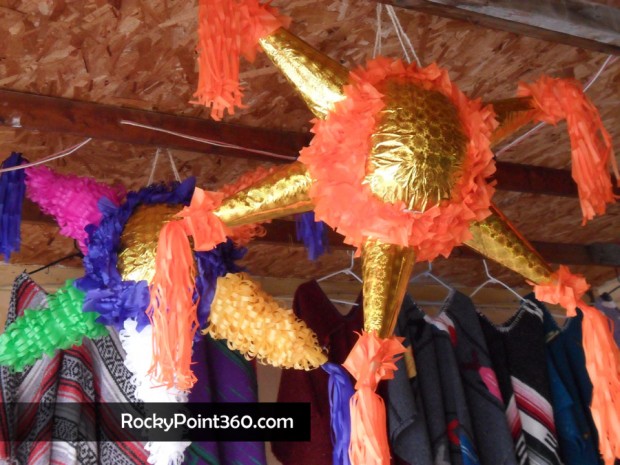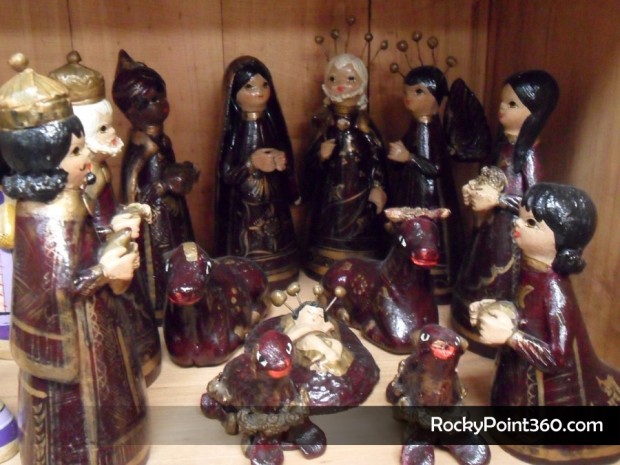By MoKa Hammeken
 We have just entered the early days of December and one can already sense the optimistic vibe of upcoming vacations… “holiday time,” relaxation, friendship, family, banquets, happiness, drinks, and above all “aguinaldos” – “holiday bonuses” (a little extra money always adds a bit of joy to the festivities).
We have just entered the early days of December and one can already sense the optimistic vibe of upcoming vacations… “holiday time,” relaxation, friendship, family, banquets, happiness, drinks, and above all “aguinaldos” – “holiday bonuses” (a little extra money always adds a bit of joy to the festivities).
With the festive spirit wound up to its peak, any excuse to celebrate is a good one! Posadas, a tradition with purely Mexican roots, are one of the wonderful reasons there are fiestas everywhere this time of year. Some posadas are in essence festive holiday parties and a reason to get together, drink, be merry, and break a piñata, or a reason to get together and stretch out the celebration while enjoying some “justified” relaxation.
It is worth clearing up a bit of controversy as currently it is common to call any holiday celebration a Posada, religious or otherwise, that takes place between Dec. 16th and the 24th. This has led to protests on behalf of some Roman Catholic groups. Still, we’ll leave that criteria up to each individual and instead focus on the immense cultural significance of the posadas since pre-hispanic civilizations in Mexico.
Prior to the arrival of the Spanish in Mexico, indigenous peoples celebrated the advent of Huitzilopochtli (God of War) during the winter period, or rather Panquetzaliztli from Dec. 17th through the 26th. These dates coincided magnificently with the period in which the Europeans celebrated Christmas. Fraile Agustino Diego de Soria, one of the first evangelizers in Mexico, requested authorization from the Pope to celebrate nine masses on the days leading up to Christmas in order to celebrate the birth of Jesus Christ as the true sun and light of the world.
In 1587, Fraile Diego de Soria obtained authorization from Pope Sixth V, allowing him to celebrate masses of “aguinaldo” (remember that term?) in the Kingdom of New Spain from Dec. 16th through the 23rd, to be held in church atriums. Along with the mass, there were representations of Christmas scenes as the church continued to educate indigenous peoples about their faith. Little by little these celebrations began to change and the image of Huitzilopochtli was substituted with that of Joseph and Mary during their long pilgrimage. Following the mass, celebrations were held replete with sparklers, fireworks, piñatas, and singing.
It was not until the 18th century when the celebration made its way into neighborhoods and homes (although it also continues within churches). Once in the neighborhoods, the celebration began to gain strength and religious music was substituted with popular chorales.
One of the representations done, and which transferred to home celebrations, was that of requesting “posada”, or rather asking for a “place at the inn.” Those present at a traditional posada divide into two groups, one representing the innkeepers and the other the pilgrims; they sing their respective verses whilst gripping their lyrics and candle. This recalls the pilgrimage of Joseph and Mary after departing Nazareth on their way to Bethlehem where they sought shelter while waiting for the birth of their son, Jesus. Once this representation is complete, or rather once “posada” is granted at one of the homes in the neighborhood, the celebration begins!
The posada celebrations begin on Dec. 16th and consist of nine rosaries, one daily that together are called a novenario, honoring the trip of the Sacred Family from Galilee to Bethlehem, as well as the nine months of gestation of baby Jesus.
So prepare your scarves and throats as soon we will begin with this bustling and joyous countdown that sets the mood and heart to enjoy Christmas. Don’t forget aguinaldos (small bags with candy) at your parties, ponche (with “piquete” for those of age), candles, fruit, and the famous sparklers that are typical at any posada.
Las Posadas
Por MoKa Hammeken
Apenas estamos sobre los primeros días de diciembre y ya se sienten las vibraciones optimistas de las vacaciones… “Épocas decembrinas”, relajación, amistad, familia, comilonas, alegría, bebidas, pero sobretodo los “aguinaldos laborales” ( poco de dinero extra siempre le añade más felicidad a las festividades).
Con el alma festiva a todo lo que da (y que a los mexicanos no nos gusta celebrar) cualquier pretexto para celebrar es bueno. Uno de esos geniales pretextos para que haya fiestas por doquier son las posadas, una tradición de raíces puramente mexicanas
Y aunque algunas llamadas posadas, algunas ya solo sean fiestas de convivio, comida, botana, bebidas y piñatas, y/ o sean solo un pretexto para juntarse y alargar el estado de ebriedad y relajación de manera “justificada”. Cabe aclarar que hay al respecto una cierta controversia, pues en la actualidad es común llamar Posada a cualquier fiesta no religiosa celebrada entre el 16 y 24 de diciembre, y esto ha motivado protestas de parte de grupos católicos romanos, pero dejemos esto al criterio de cada persona y hablemos mejor del bagaje cultural inmenso, que se remonta desde las civilizaciones prehispánicas de México.
Antes de la llegada de los españoles los nativos celebraban el advenimiento de Huitzilopochtli (Dios de la Guerra) durante la época invernal o Panquetzaliztli, que iba del 17 al 26 de diciembre, y esta coincidía magníficamente con la época en que los europeos celebraban la Navidad. Entonces, el fraile agustino Diego de Soria, uno de los primeros evangelizadores solicitó autorización al Papa para celebrar nueve Misas en los días anteriores a la Navidad para celebrar el nacimiento de Jesucristo como el verdadero sol y luz del mundo.
En 1587, fray Diego de Soria obtuvo del Papa Sixto V la bula autorizando la celebración en el Virreinato de la Nueva España de unas Misas, llamadas de aguinaldo (¿les recuerda algo el nombre?) del 16 al 23 de diciembre y que se realizarían en los atrios de las iglesias. Junto con las misas se representaban escenas de la Navidad, para continuar educando sobre la fe a los naturales de estas tierras. Poco a poco estas celebraciones fueron cambiando y la imagen de Huitzilopochtli fue sustituida por la de José y Maria en su largo peregrinar. Luego de la Misa se realizaban festejos con luces de bengala, cohetes,piñatas y villancicos. Pero no fue si no hasta en el siglo XVIII cuando la celebración se trasladó a los barrios y casas (aunque no dejó de realizarse en las iglesias), donde fue tomando mucha fuerza y la música religiosa fue sustituida por el canto popular. Una de las representaciones que se hacían y se trasladaron a las celebraciones caceras, es el de “pedir posada”. Los presentes se dividen en dos grupos, unos representado a los posaderos y otros a los peregrinos, y se cantan los respectivos versos con su hoja y vela en mano (pues no se de muchos que se sepan la letra fuera de“ohoooo os pido posada…”). Esto recuerda el peregrinaje de María y José desde su salida de Nazaret hasta Belén donde buscan un lugar donde alojarse para esperar el nacimiento del niño Jesús. Terminada esta representación eso se da comienzo a la fiesta.
Ahora bien, la idea de que las posadas se empiecen a celebrar a partir del día 16 de diciembre es por que consiste en nueve rosarios, uno diario llamados en conjunto novenario, en el que se rememora el viaje de la Sagrada Familia desde Galilea hasta Belén, como también los 9 meses de la gestación del niño Jesús.
Entonces preparen sus bufandas y sus gargantas que dentro de poco empezaremos con esta bulliciosa y alegre cuenta regresiva que nos pone el ánimo y el corazón a tono para disfrutar la Navidad. No olviden en sus fiestas los aguinaldos (bolsa con dulces), el ponche (con piquete, para los mayores), las velas, la fruta y las famosas luces de bengala, tan típicos de toda posada.
